Apart from divine intervention, there is little other explanation for the twelve-century survival of Ireland’s most precious literary possession: the Book of Kells.
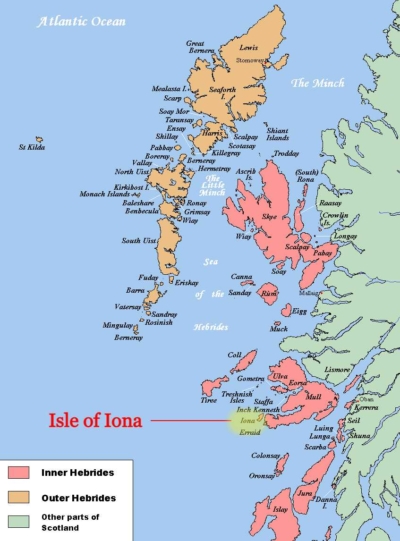 If you want to be technical about it, the Scots could lay claim to this ancient book as well (but all of Ireland would fight me on that!) It was created on the island of Iona in the Inner Hebrides off the west coast of Scotland in the early 800s AD.
If you want to be technical about it, the Scots could lay claim to this ancient book as well (but all of Ireland would fight me on that!) It was created on the island of Iona in the Inner Hebrides off the west coast of Scotland in the early 800s AD.
Tiny Iona is not even one-and-a-half square miles and has a little over 100 residents today, yet in 563 AD a group of monks from the Emerald Isle braved the turbulent waters of the Irish Sea in a rickety boat to go there. For some unknown reason, they took a liking to Iona’s barren landscape, inhospitable rock formations, harsh weather, lack of food, and all around inhumane living conditions. And of course, being Irish, they said, “Ah, lads, this is the perfect place to settle.” (Translation from the ancient Celtic by Peter Darcy.)
Those guys were real monks.
Their leader was the fascinating Irish missionary saint, St. Columban, and Iona was his 36th monastic settlement. Columban (sometimes called Columba or Columkille) founded communities in Ireland, France, Italy, and the British Isles but kept getting kicked out of every place he settled because he had the uncomfortable habit of rebuking churchmen for their sinful and corrupt lifestyles.
As I said, a real monk.
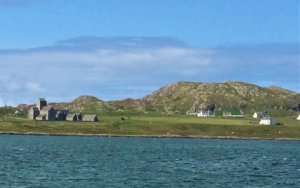 Three centuries later, the spiritual descendants of St. Columban’s merry band of Irish monks were still living on Iona (again, for some unknown reason), and they were the ones who produced the Book of Kells. So, yes, this is an Irish treasure of the first order, and they are justifiably proud of its incredible history and beauty.
Three centuries later, the spiritual descendants of St. Columban’s merry band of Irish monks were still living on Iona (again, for some unknown reason), and they were the ones who produced the Book of Kells. So, yes, this is an Irish treasure of the first order, and they are justifiably proud of its incredible history and beauty.
Illumination as a Mystical Art Form
We’ll get to the book’s name and survival factor in a bit, but first, something more fundamental: What exactly is the Book of Kells?
Well, it’s no ordinary book. It’s a book of the four Gospels – a large and very ornate book called an illuminated manuscript. Its luminosity becomes very apparent when you glance even at a single page.
“Illuminated” describes the types of Medieval bibles and prayer books that were decorated with tiny images, flourishes, and designs all over the pages, particularly those large, embellished initials (called drop-cap letters) that light up the beginnings of pages and paragraphs.
Every single word of the book was hand-lettered with the most exquisite and detailed calligraphy imaginable (way before the advent of the printing press), and its overall presentation is colorful, attractive, even humorous in places, and fabulously interesting.
A medieval theologian labeled it “the work of an angel, not of a man,” and in more recent times one writer called it a “mystical masterpiece of illumination.” I totally agree.
It is a written text, yes, but it’s probably better to call it a work of art, a word-painting composed of verses, tiny designs, and lively pictures that give emphasis to the words. To “illustrate” the point, here are two pages and one quaint detail from the Book of Kells:
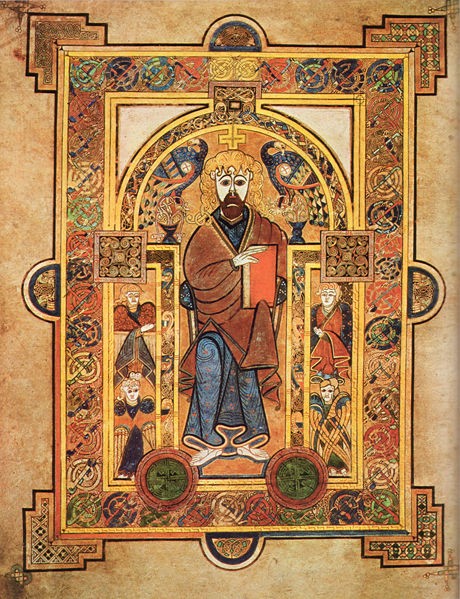
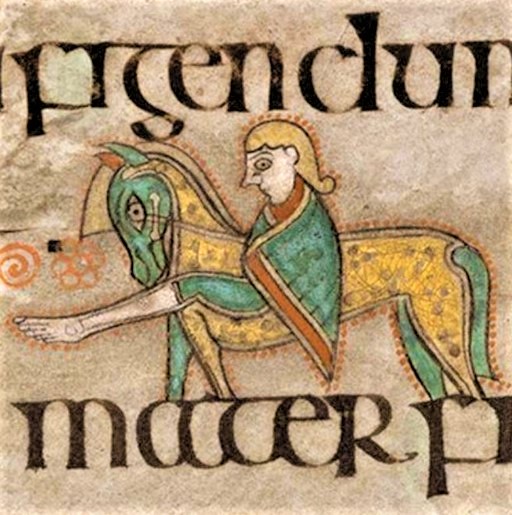
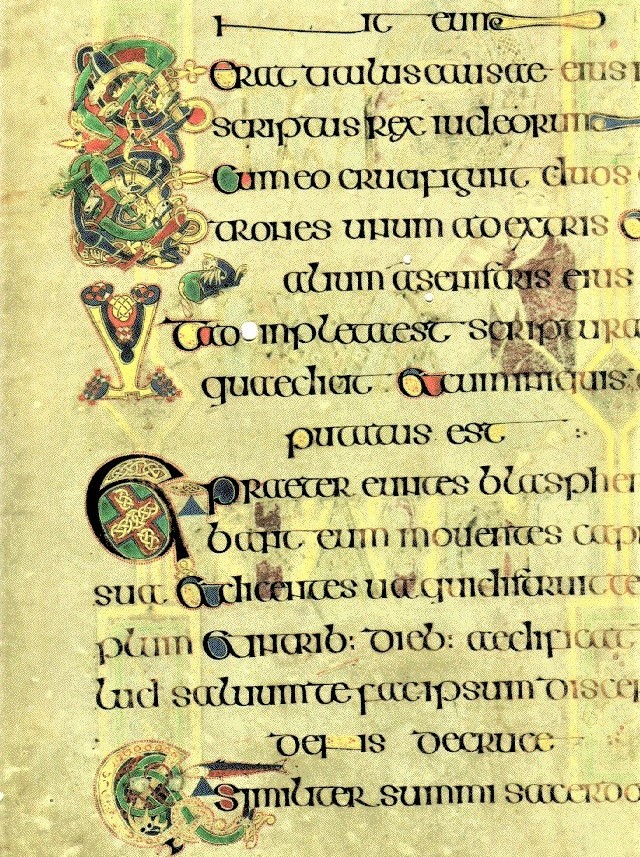
A Wonder of the Medieval World
The Book of Kells is truly a wondrous book. It consists of 680 pages, and all but two are illustrated in the above manner. Here are a few things to know about it:
- The book measures 13” x 10” (slightly larger than a large family bible but thicker);
- The text is entirely in Latin;
- Its calligraphy is absolutely perfect throughout – written in the rounded, recognizably Irish script sometimes called the “Celtic Tree Alphabet”;
- Three anonymous scribes copied the book and are identifiable by their unique lettering styles: scholars have named them simply Hand A, Hand B, and Hand C;
- There is a blend of artistic styles throughout the pages – Celtic, Islamic, North African, and Near Eastern – but, ironically, there seems to be very little stylistic influence from the continent of Europe;
- The huge tome is made of 38 groups of sheets all sewn together at the ends of the pages to create a single book;
- Its pages are not paper but rather vellum, the skins of deer, cattle, or calves, which was the standard material used for the pages of ancient books;
- The book originally had a gold and jeweled cover, which was probably lost when it was stolen from the monastery in the year 1007 AD;
- It contains many fascinating and even humorous depictions of animals frolicking around on its pages: an otter with a fish, a peacock, serpents eating their tails, lions breathing fire, two mice fighting while cats watch, buzzing insects, etc.
- It also bears the oldest surviving portrait of the Virgin Mary, the only woman whose image appears in the book.
The photos below show the actual Book of Kells on display in Trinity College in Dublin and a colorful medieval cat chasing a medieval mouse!
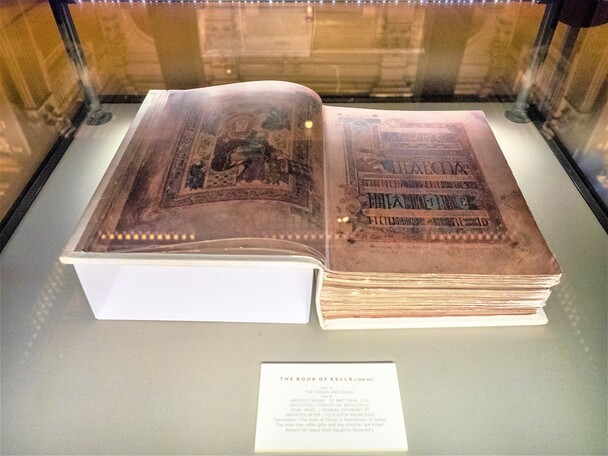
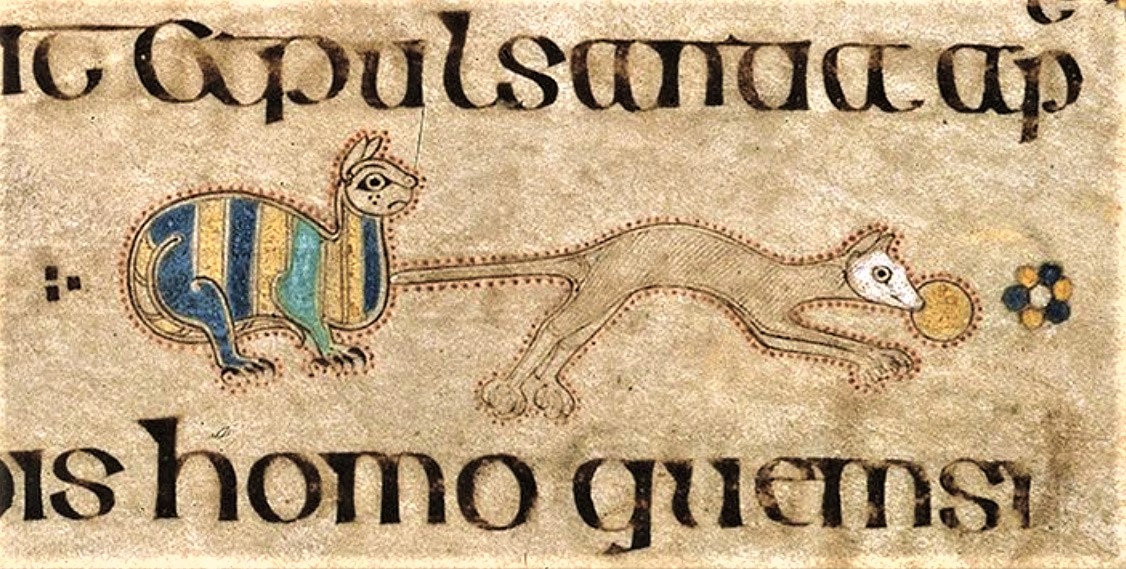
The Survival Factor
And finally, we get to the incredible longevity of this amazing book.
Perhaps I was overstating things when I said that the book’s preservation was mainly due to divine intervention, but not by much. I’m sure God protects holy artifacts like the Book of Kells, but the direct secret of its longevity is probably more human than divine – as in Vikings. Let me explain.
Evidence indicates that the Book of Kells is incomplete. The illumination project was probably left unfinished due to Viking raids that swept the Hebrides in 795 AD and then again in 806.
The monks may have fled with the book after the first raid, or if they didn’t, they surely did so at the second raid when sixty-eight of their monks were killed and their monastery and land were ravaged.
Were the scribes themselves killed by the Vikings? We will never know, but it’s a likely reason why the project was left unfinished.
The 806 raid forced the rest of the monks to abandon their monastery on Iona (today you can see ruins and some reconstructions on the island) and move to an associated monastery on the Irish homeland, just forty miles north of Dublin. The name of the town: Kells. There the book rested for eight hundred years.
Other elements of its history can also be weighed as real threats to the book’s survival. I mentioned the theft of the book from the monastery in 1007. This was not without detrimental effects: it is believed that some thirty pages of the book were lost when the thief ripped off the bejeweled cover and then buried the book in the ground until it was found several days later.
Then, when the wicked Oliver Cromwell invaded Ireland in 1649 with his army of Catholic-hating Calvinists, he garrisoned some of his troops in Kells, and the monks once again were forced to shield the book from ravaging forces.
The book was secreted away to Dublin and eventually given over to Bishop Henry Jones, who was an alumnus of Trinity College. In 1661 the good bishop donated the Book of Kells and the Book of Durrow (another ancient bible created by St. Columban’s monks!) to Trinity College where it has been kept to this day.
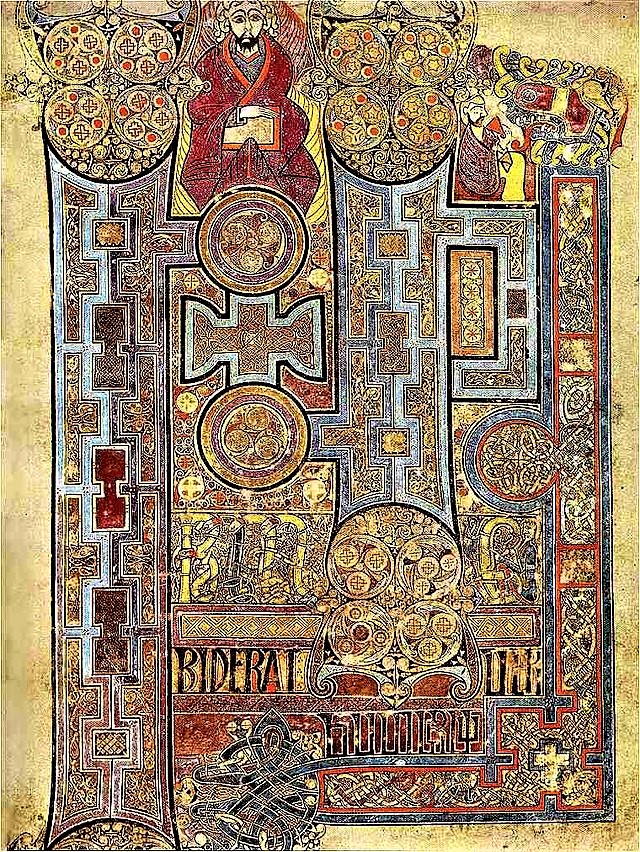
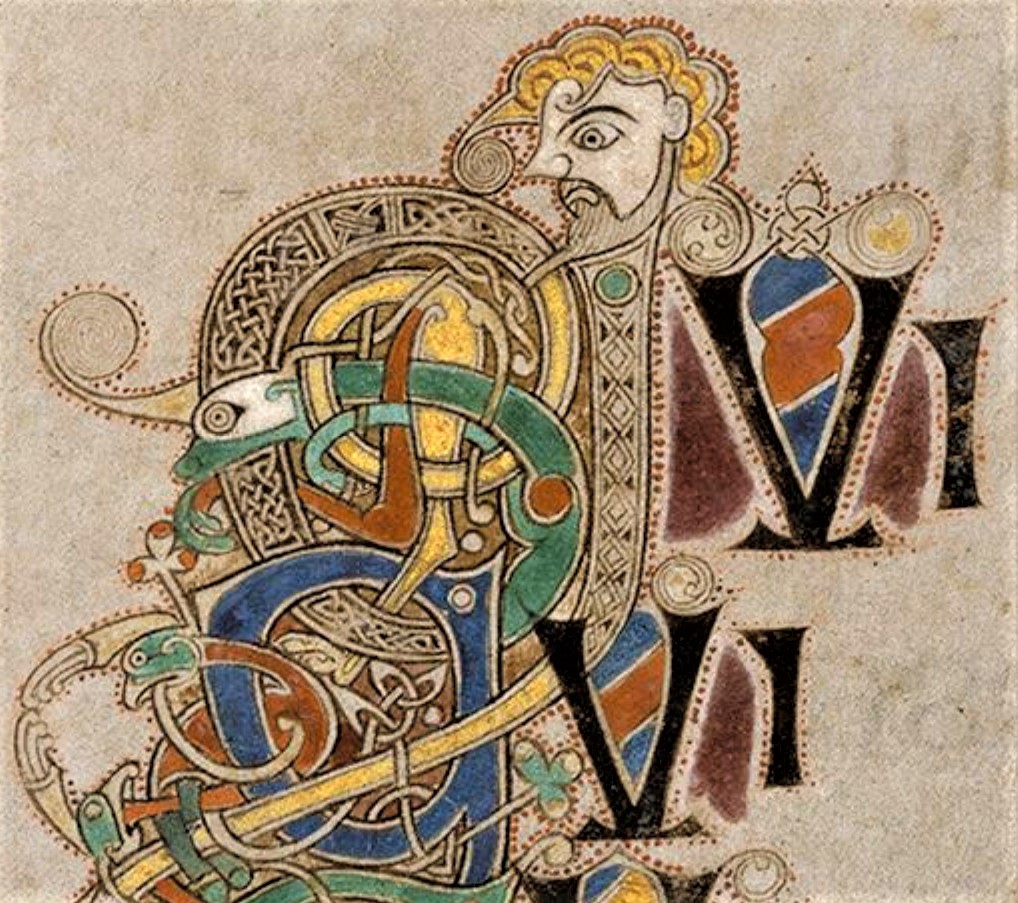
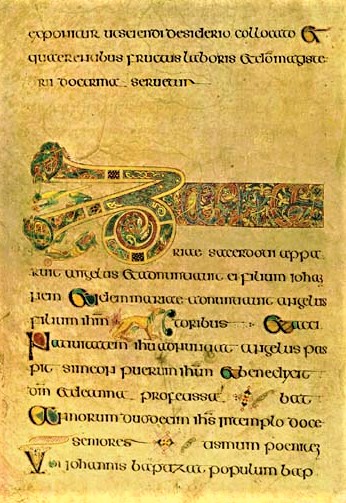
The Tree of Life
The real reason why the Book of Kells has survived for so long, however, touches on the very core of our identity as Catholics. The Church that Christ founded has held this priceless artifact in its bosom for twelve centuries. Only a people whose identity is rooted in a reality outside of time can preserve something for so long through time.
Our Church is like an immense tree that Christ Himself planted on the Hill of Calvary. It has been watered and tended by the Apostles and their successors for 2000 years. It is a Tree of Life that has set down roots in every human culture and spread its immense, life-giving branches over every day and age to bear spiritual fruit for the salvation of souls.
Each place and time produces more fruit on the tree, unique to the saints of the age. Their particular heroes, martyrs, pastors, scholars, missionaries, teachers, and scribes make their contributions and give us the hope of heaven. Parents and families hand on the gifts of faith from generation to generation, and each age produces something of spiritual value for the world.
In every place, this Church holds up God’s Beauty, Truth, and Goodness before the eyes of the world to proclaim the wonders of His saving grace to all. And every now and then, fervent souls like St. Columban’s men produce a work of art that lasts a thousand years.
See It Up Close
I’ve added links to a couple videos that you might find fascinating. The first (~4 minutes) shows close-ups of the exquisite imagery and calligraphy in the Book of Kells with amazing Irish music in the background. Truly fascinating! If you only have time to watch one of the two videos, this is it. The second shows the Book of Kells on display in Trinity College, Dublin. Enjoy!
The Book of Kells – Iona (4:19)
Magnificent New Display Case for the Book of Kells (2:24)
———-
[Note: This article is a reproduction of the Sacred Windows Email Newsletter of 3/06/22, so it does not end with the regular Soul Work section. Please visit our Newsletter Archives.]
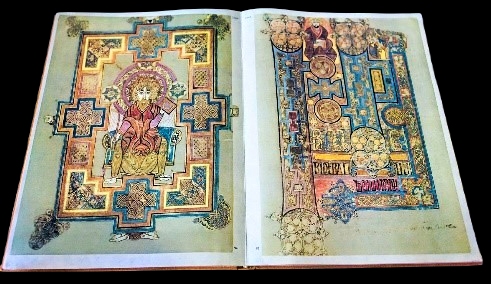
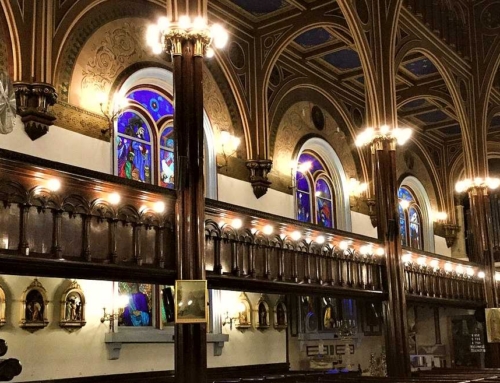
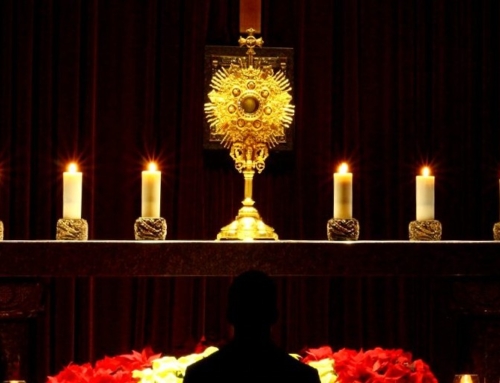

Thank you for introducing this sacred treasure! It is a treasure that that these books have been saved for mankind . My faith is strengthened by the love of Christ carried through the generations and the hope that it will continue to be shared!
Hello Marilyn, thanks you very much for your kind words! Helping people grow in faith is the whole purpose of writing these articles, and it’s so nice to hear that this one helped you. We have been so blessed by the treasures of our faith! Thanks again.
[…] noted in past newsletters some of the missionary activity that took place during those centuries (St. Columban in Ireland, France, and Italy; St. Boniface in Germany; Sts. Cyril and Methodius in Eastern […]
[…] It’s known as The Saint John’s Bible , and it is “The first hand-written, hand-illuminated monumental Bible to be commissioned by a Benedictine monastery in 500 years.” That is not a pious boast. It’s a fact. Newsweek called it, simply, “America’s Book of Kells.” […]